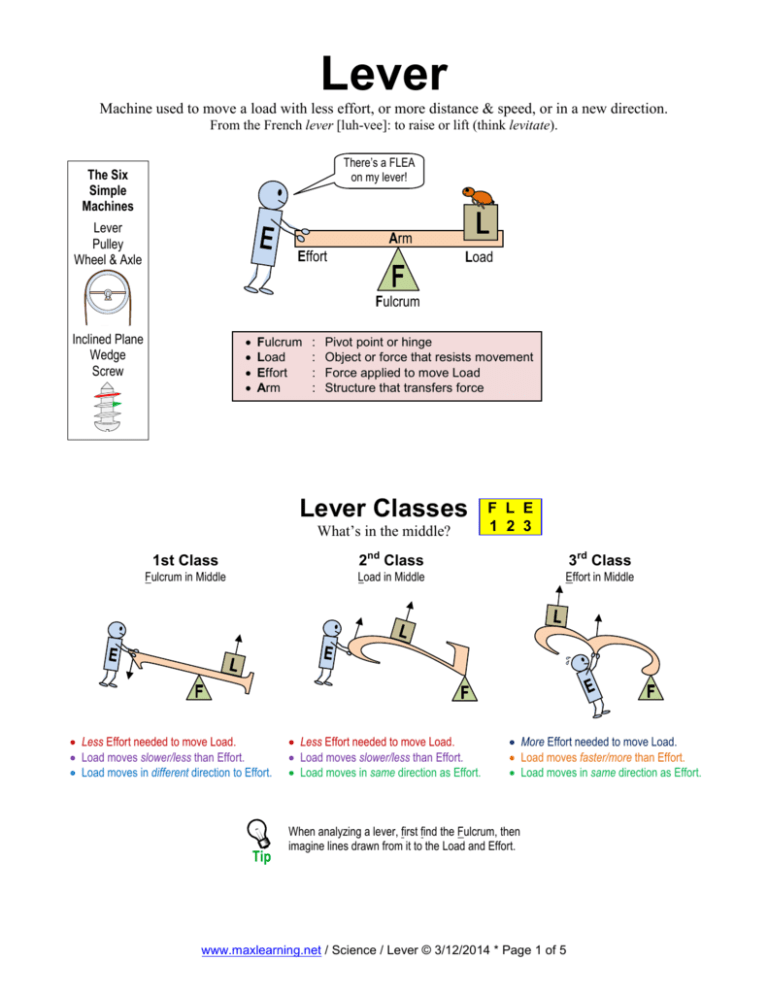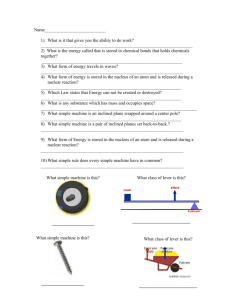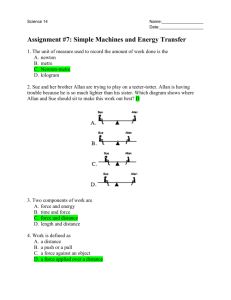Lever Classes - MaxLearning.Net
advertisement

Lever Machine used to move a load with less effort, or more distance & speed, or in a new direction. From the French lever [luh-vee]: to raise or lift (think levitate). There’s a FLEA on my lever! The Six Simple Machines Lever Pulley Wheel & Axle Arm Effort Load Fulcrum Inclined Plane Wedge Screw • • • • Fulcrum Load Effort Arm : : : : Pivot point or hinge Object or force that resists movement Force applied to move Load Structure that transfers force Lever Classes What’s in the middle? F L E 1 2 3 1st Class 2nd Class 3rd Class Fulcrum in Middle Load in Middle Effort in Middle • Less Effort needed to move Load. • Load moves slower/less than Effort. • Load moves in different direction to Effort. Tip • Less Effort needed to move Load. • Load moves slower/less than Effort. • Load moves in same direction as Effort. • More Effort needed to move Load. • Load moves faster/more than Effort. • Load moves in same direction as Effort. When analyzing a lever, first find the Fulcrum, then imagine lines drawn from it to the Load and Effort. www.maxlearning.net / Science / Lever © 3/12/2014 * Page 1 of 5 Lever Examples Arrows = Direction of Movement L & E can be above or below Arms 1st Class 2nd Class 3rd Class Seesaw Wheelbarrow Crane Pry Bar Bottle Opener Cantilever Bridge Claw Hammer Door Sports Bat Double 1st Class Double 2nd Class Double 3rd Class Scissors Nutcracker Tweezers Add to these lists as you discover more lever examples. (The same item may fit in more than one class.) 1st Class Balance Scale Spatula (if push handle down) Catapult (if launcher at end) 2nd Class Wrench Spatula (if lift handle up) Stapler / Paper Cutter 3rd Class Broom / Rake / Hoe Striking Hammer / Hatchet Catapult (if launcher in middle) Double 1st Class Pliers / Wire Cutters Tin Snips / Garden Shears Double 2nd Class Wrist Squeezer Fireplace Bellows Double 3rd Class BBQ Tongs Human Limbs / Jaw Hybrid: Nail clippers: 2nd (top) + Dbl 3rd (bottoms) www.maxlearning.net / Science / Lever © 3/12/2014 * Page 2 of 5 Law of the Lever The Work input to a lever equals the Work output by the lever. Work = Force × Distance Force of Effort [Input] WorkIN WorkOUT FE DE = FL DL Distance to Effort (from Fulcrum) This lever lets me move the load with half the effort! Force of Load [Output] 20 lb 10 lb 4 ft 2 ft FEDE = FLDL “whistle feedee fiddle while you work” Distance to Load (from Fulcrum) In a real lever, a portion of Work is lost to friction. FE DE = FL DL (10lb)(4ft) = (20lb)(2ft) 40 ft-lb = 40 ft-lb Rule of Thumb The longer the Effort arm, the easier it is to move the Load. Lever Problems Find FL FE DE = FL DL 9 lb FL (9 lb)(3 ft) = FL(1 ft) 3 ft 1 ft (9 lb)(3 ft) = FL(1 ft) (1 ft) (1 ft) 27 lb = Find FE 4 ft 12 lb FE DE = FL FL DL FE (4 ft) = (12 lb)(2 ft) FE (4 ft) = (12 lb)(2 ft) (4 ft) (4 ft) 2 ft FE FE = 6 lb FE DE = FL DL DE 4 ft 16 lb Tip Archimedes (Greece, ~200 BCE) Units of Measure Find DE 6 lb Give me a place to stand, and a lever long enough, and I will move the world. (16 lb)(DE) = (6 lb)(4 ft) (16 lb)(DE) = (6 lb)(4 ft) (16 lb) (16 lb) DE = 1.5 ft Mentally multiply respective Effort and Load forces and distances to ensure they yield identical products. Force units × Distance units = Work units 1 Pound 1 Foot 1 Foot-Pound 2 lbs 3 ft 6 ft-lbs 1 Newton-meter (Joule) 1 Newton 1 meter 2N 3m 6 Nm (J) Conversion Factors 1 ft-lb = 1.35 Nm = 1.35 J 1 Nm = 1 J = 0.74 ft-lbs Since levers rotate in arcs (vs. straight lines), the technically-correct terminology is Moment = Force × Distance, where “Moment” is the turning force or torque. www.maxlearning.net / Science / Lever © 3/12/2014 * Page 3 of 5 Lever Mechanical Advantage (MA) MA: Factor by which a lever changes the force, distance & speed, or direction of work. Tradeoff: Increased output force means less output distance & speed and vice versa. Deriving MA FE DE = FL DL FE DE = FL DL FE DL FE DL DE = FL DL FE Distance Ratio DE MA = DL [Input arm] E DE: Distance to Effort (from Fulcrum) DL: Distance to Load (from Fulcrum) Force Ratio L [Output arm] MA = DE / DL “made dull by distance” The Load is also called the resistance, because it resists the Output Force that moves it. Load [F out] MA = Effort [F in] OR FL: Force of Load [Output Force] FE: Force of Effort [Input Force] MA = L / E “male force” L O U T P U T MA = Output / Input “Chairman MAO is In” A ratio is a relation between numbers Input Force Effects of MA Factor multiplier Output Force FE × MA = FL “FEMA fights FLoods” Federal Emergency Management Agency FE × MA = FL If MA > 1 More Output Force If MA = 1 Equal Output Force If MA < 1 Less Output Force (Less Output Distance & Speed) (Change in Direction) (More Output Distance & Speed) 1st or 2nd Class Lever with Fulcrum nearer Load. 1st Class Lever with Fulcrum centered. 1st or 3rd Class Lever with Fulcrum nearer Effort. Advantage: MA>1 increases my force, so I can move the Load with less effort. Tradeoff: MA=1 transmits but doesn’t increase or decrease my force. Tradeoff: MA<1 decreases my force, so I must use more effort. DE < DL DE > DL DE = DL Tradeoff Load moves less and slower. DE > DL Advantage Load moves farther and faster. Advantage Load moves in different direction. MA < 1 Fraction Farther Faster DE < DL MA Problems Speed Factor = 1 / MA Find the MA of this lever. 9 lb 27 lb If MA = 2, speed factor is ½ (halved) If MA = ½, speed factor is 2 (doubled) 3 ft R e s i s t A D n c e MA = L / E = 27 lb / 9 lb = 3 √ 1 ft If MA = 5, what Load can be moved with a 10 lb Effort? If MA = 4, what Effort will move a 20 lb Load? MA = DE / DL = 3 ft / 1 ft = 3 FE × MA = FL 10 lb × 5 = FL 50 lb = FL FE × MA = FL FE × 4 = 20 lb FE = 5 lb Circumference Effort Circle CE = 2πrE 2π(1) 2π MA = ½ 36° Circumference Load Circle CL = 2πrC 2π(2) 4π 36° Load Arc 36° Effort Arc 36/360 (CL) 36/360 (CE) 1/10 (2π) Load Arm is twice Effort Arm 1/10 (4π) 0.2π 0.4π Load Arc is twice Effort Arc Load travels twice as fast! www.maxlearning.net / Science / Lever © 3/12/2014 * Page 4 of 5 Your Turn! Matching 1) ___ Fulcrum a. Transmits force 2) ___ Load b. Input force 3) ___ Effort c. Pivot or hinge 4) ___ Arm d. Force × Distance 5) ___ Work e. Resists movement True or False 6) ________ A wheelbarrow is a 3rd class lever. 7) ________ A 3rd class lever trades extra effort for more speed. 8) ________ Force input must equal Force output. 9) ________ A longer Effort Arm requires less effort. 10) _______ A fractional Mechanical Advantage increases speed. 11) Find FL 12) Find MA using both Distance and Force Ratios. 25 lb FL 12 lb 8 lb 4 ft 2 ft 2 ft 3 ft 13) Find MA if 50 lbs of Effort moves a 300 lb Load. Answers: 1c, 2e, 3b, 4a, 5d 14) Find MA if Effort Arm is half Load Arm. 6F, 7T, 8F (Work, not Force), 9T, 10T 11) 50 lb 12) 8/12 = 2/3 13) 6 14) 1/2 www.maxlearning.net / Science / Lever © 3/12/2014 * Page 5 of 5







